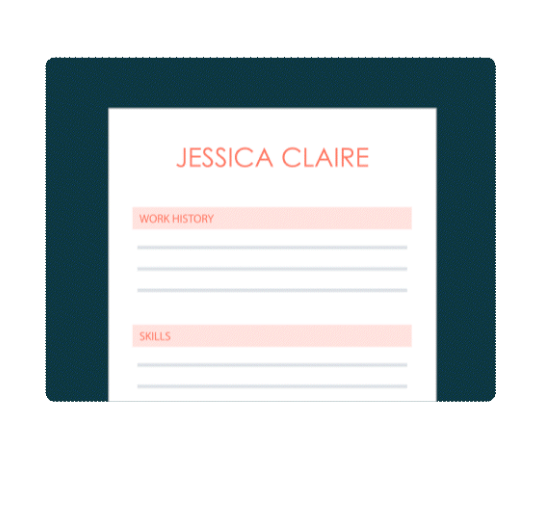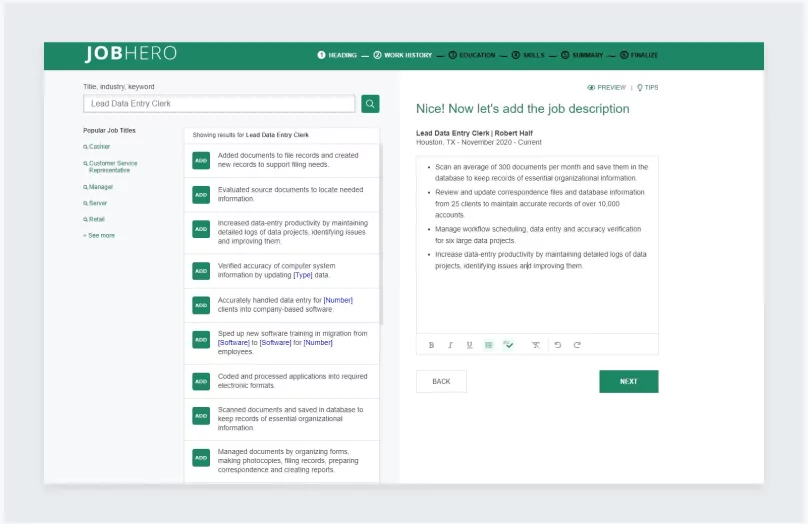This article has all the information you need to become a medical scribe, including the skills you need, education and average pay rates. Once qualified, give yourself the advantage over other job seekers by studying professionally written medical scribe resumes. You’ll learn what information and descriptions help your colleagues find positions.
Pair this knowledge with templates from our Resume Builder alongside AI-powered text templates and intuitive formatting to help you finalize an application.
Need cover letter guidance? Add a cover letter to your resume using our cover letter formats how-to guide and add value to your resume.
Want to boost your resume? Your Jobhero subscription comes with a complimentary cover letter builder. Once you choose a cover letter template, the builder will suggest job-specific skills and prewritten entries, allowing you to save multiple letters for various applications fast.

Create your professional resume in just minutes.
- Choose from 20+ recommended templates
- Add pre-written experiences, skills and summary
- Download and send
What Does a Medical Scribe Do?
A medical scribe assists physicians with non-clinical and administrative tasks. They tend to work in hospitals and medical clinics to gather a patient’s medical information and write it down or enter it into a digital record system.
A medical scribe’s primary responsibility is documenting medical data. Typical medical scribe duties include:
Technical tasks, such as entering medical information into an online database.
Clerical tasks include writing down medical information in a medical record system.
Organizational tasks, such as organizing patient charts.
Entering medical records into a portal, such as the electronic health record (EHR.)
Charting doctor and patient encounters, such as documenting patients’ medical concerns.
Interpreting and transcribing physician/patient interactions for medical reports, including patient history, discharge summaries and routine examinations.
Writing letters, such as referrals for doctors.
Helping with e-prescribing, such as electronically prescribing medicine
Keeping track of medical testing times, making sure patients get results.
Submitting reports to healthcare providers for review and approval.
How Do You Become a Medical Scribe?
Unfortunately, the U.S. Bureau of Labor Statistics (BLS) saw a notable decrease in medical scribe opportunities and estimates a 7% decline between now and 2031. Despite this reduction in options, they still project 9,300 job openings yearly to help replace career transfers or retirees. To successfully compete for these opportunities, you can follow these steps to become a medical scribe.
Get your high school diploma.
Based on a review of medical scribe job advertisements across the country, a minimum requirement for this job is a high school diploma or equivalent. However, many jobs require a certification or a relevant college degree.
Sign up for a medical training program.
Many vocational schools, community schools and medically minded colleges offer hands-on training programs. These training programs teach medical terminology, paid residency training and additional skills such as typing and shorthand. The Association for Healthcare Documentation Integrity (AHDI) keeps an up-to-date list of approved training programs.
Sign up for a certification.
According to the BLS, certification isn’t required, but this extra step can signal your advanced training and technical knowledge to hiring managers, helping boost you to the top of the candidate pile. You can find national certifications like the Registered Healthcare Documentation Specialist (RHDS) and the Certified Healthcare Documentation Specialist (CHDS) through AHDI.
Most board examinations require applicants to complete 200 hours of clinical instruction, although exceptions exist for individuals with existing medical licenses or certifications. You’ll need to pass the 100-question test with 80% or higher.
To raise your chances of finding an excellent medical scribe position, craft a high-quality resume that describes your skills and education in the medical area. Use our medical scribe resume samples as a resource.
After composing a well-written resume, start your search for medical scribe employment opportunities. Utilize connections you have made in training programs to help secure a job.
Medical Scribe Skills
This job requires long shifts, which demand commitment and motivation. The fast-paced environment of a hospital or medical facility calls for quick thinking and good stress-management skills. A medical scribe must have excellent communication skills to effectively work with physicians, lab technicians and nurses.
Additional learned technical and social soft skills to succeed as a medical scribe include:
Hard skills:
Soft skills:
Insights from a Medical Scribe
Still need more information about what it's like to be a Medical Scribe? We asked professionals with plenty of years of experience in the field and this is what they had to say.
What is the common career path for a Medical Scribe?
Minimum requirements to become a medical scribe is a high school diploma but a degree or currently enrolled in a degree program is preferred. Most people acquire some computer skills to manage entries of certain information. Most common are MS Office-related skills.
What should someone consider before becoming a Medical Scribe?
Things to take into consideration before entering into a scribe program with a physician is that these jobs are becoming more streamlined each day. This means that facilities are now using EHR's replacing what a scribe did in the past, to maintain human error to a minimum.
What type of person excels in this job?
A quality that might help you do a great job as a Medical Scribe is a passion for medicine and learning. A high conscientious personality and a good understanding of terminology with the ability to self-motivate yourself are traits of an excellent Medical Scribe.
What are some of the most important skills for Medical Scribes to have?
Strong written and verbal communication skills would be a good place to start. Some knowledge of office and other clerical and computer skills are very important as well.
What do you find to be the most rewarding aspect of being a Medical Scribe?
The most rewarding aspect of becoming a medical scribe is the rate at which you learn how to treat patients. Understanding how to be compassionate around certain situations especially if your goal is to become a physician one day.
How Much Do Medical Scribes Get Paid?
Medical Records and Health Information Technicians, which include Medical Scribes, are paid an average salary of $35,900. The lowest paid Medical Scribes make $23,300 annually; while the highest paid earn $59,200.
Top 10 States for Medical Scribe Salary
Medical Scribes in the following states make the highest median salary in the U.S.:
Medical Scribe Resources
We put together a list of online resources, which can help you find more information about a career as a Medical Scribe.
On the Web
ScribeAmerica
A resource that includes enrollment requirements for aspiring Medical Scribes.
Becker Hospital Review
Seventeen things to know about medical scribes.
On LinkedIn
Medical Scribe
Top 24 Medical Scribe Profiles.
Medical Scribe Jobs
A resource of Medical Scribe Jobs in your area.
On Twitter
@EMA_CIMs
Emergency Medical Associates (EMA) group.
@Phys_Recruiting
A medical Scribe recruiting service.




